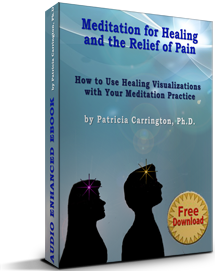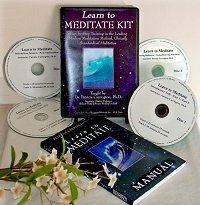Dr. Patricia Carrington's award winning meditation technique CSM (Clinically Standardized Meditation) is a clinically sensitive meditation method developed by the Medical Department of New York Telephone Company and used by numerous medical institutions, organizations, and individuals worldwide. For information click here.
Meditating to Reduce Stress
Conquering Anxiety with Meditation
Patricia Carrington, Ph.D.
Author of “The Book of Meditation”
Anxiety is not only a driving force behind most severe psychiatric conditions, but one of the chief stumbling-blocks to their effective treatment. The highly anxious person is frequently afraid to talk about the very things which are most important for him or her to face. Unmitigated anxiety leading to panic is so painful an emotion that it is usually avoided at all costs, even if the costs be the undermining of the patient’s psychiatric treatment. Any auxiliary therapy that can reduce anxiety is therefore of help, one reason why tranquilizers are so widely prescribed.
In observing patients who are meditating, my psychotherapist colleagues and I have noticed that anxiety is lessened in a majority of them as they continue in their practice of meditation. These people now worry less about their jobs, their families and a host of anticipated dangers which formerly paralyzed their initiative. They seem protected or cushioned from these strains.
As their anxiety lessens, they also tend to be more relaxed and proficient at handling many tasks. This increased ‘coping ability’ is different from that which we usually see in patients on tranquilizers or anti-depressant medication. Drugs may restore a patient to feeling more ‘normal’ – ‘I feel like my old self since I’ve been taking my tranquilizer’ – but the drug is not likely to foster personal growth or help the person experience life in a new way. By contrast, after commencing meditation, people often find themselves reacting in ways they have not done before. The practice of meditation tends to open up new horizons rather than restoring a former state of affairs. For this reason some psychiatrists familiar with meditation will recommend to patients that they try learning meditation, before prescribing tranquilizers for them.
Another advantage of meditation over drugs is the fact that the meditator does not ordinarily lose alertness or become groggy. People taking high dosages of tranquilizers, on the other hand, often complain that they feel dull or sleepy and that their reaction times are slowed down. Because of this, people taking these kinds of drugs are regularly cautioned not to use machinery or engage in other activities where quick reflexes are required. By contrast, meditators are frequently more alert, nimble and aware of their surroundings than they were before.
The very fact that meditation is something which patients can do for themselves also builds strength and confidence. People, who meditate when anxious and thereby regain a sense of calm, sense that they are in control of their own life and that no drug is doing the work ‘for them’. One lesson of meditation, then, is that one can bring physical and mental processes under one’s own control, a basic step in coping with anxiety.

